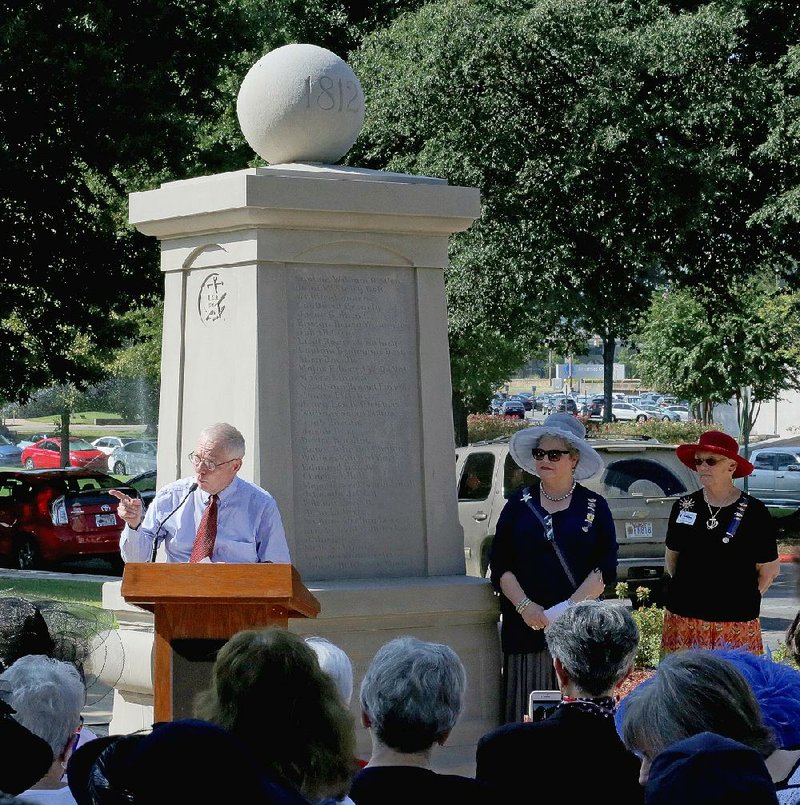Arkansas kicked Peter Caulder -- along with other free black people -- out of the state in the mid-1800s. Now it's honoring him.
The black pioneer's name was etched Friday onto the War of 1812 Memorial Fountain on the southeast lawn of the state Capitol beside the names of dozens of other soldiers who fought the British in the early 19th century.
Gov. Asa Hutchinson also proclaimed Friday as Peter Caulder Remembrance Day, and the Arkansas chapter of the U.S. Daughters of the War of 1812 honored Caulder with a ceremony at the foot of the monument.
Billy Higgins, a University of Arkansas at Fort Smith professor, spoke briefly about Caulder at the ceremony. Higgins wrote a book, A Stranger and a Sojourner: Peter Caulder, Free Black Frontiersman in Antebellum Arkansas, about Caulder's life.
"Peter Caulder is a genuine hero of mine," Higgins said in an interview, noting that it was gratifying to see the subject of his book celebrated.
The War of 1812 Memorial Fountain was erected on the Capitol grounds in 1917 to honor veterans of the war who had ties to Arkansas -- many of whom homesteaded in the Natural State after the conflict. At the time, only a few soldiers were known.
Over the past century though, researchers have discovered that more than 700 who fought in the War of 1812 had Arkansas ties. Because of the size of the monument, only about 60 names are displayed.
Caulder is among three names to be added to the monument since the early 2000s, when the site was refurbished.
Capitol historian David Ware said the marker is likely his favorite on the Capitol grounds because of its understated nature and functionality. As any passers-by who have visited it on hot day can attest, the water fountain still works.
"If this monument is not forgotten, the names on it aren't forgotten, and the 700 others aren't forgotten," Ware told about 40 people who gathered Friday.
Caulder was born in South Carolina in 1795, joining the 3rd U.S. Rifles in 1814 after British troops burned Washington, D.C.
The U.S. Army listed Caulder, who was of African descent, as a "colored man," and several U.S. Censuses labeled him "mulatto."
Caulder and several other black soldiers came to Arkansas down the Arkansas River with an elite rifle regiment assigned to man the westernmost military outpost, which later became Fort Smith.
After serving a decade there, Caulder married the daughter of a free black pioneer who had settled near the White River in Marion County.
Caulder was illiterate, signing his name with "X," but he and his family built a successful life in Marion County for more than 30 years.
Higgins, whose book was published by the University of Arkansas Press in 2004, said Caulder, his wife and seven children were integrated and interacted frequently with their white neighbors.
Higgins spent about seven years tracing Caulder through old county and census records.
"I wouldn't have worked this hard if I didn't really admire Peter Caulder," Higgins said.
Caulder's time in Arkansas ended abruptly after the Arkansas General Assembly passed a law in 1859 that mandated any free people categorized as "black" or "mulatto" leave Arkansas within a year or be enslaved.
The Caulders fled their land, moving to southern Missouri. At that point, Caulder's paper trail ends, but Higgins found traces of his descendants in Bollinger County, Mo., years later.
Descendants of Caulder still live in Missouri; they're now white.
Metro on 09/24/2017
